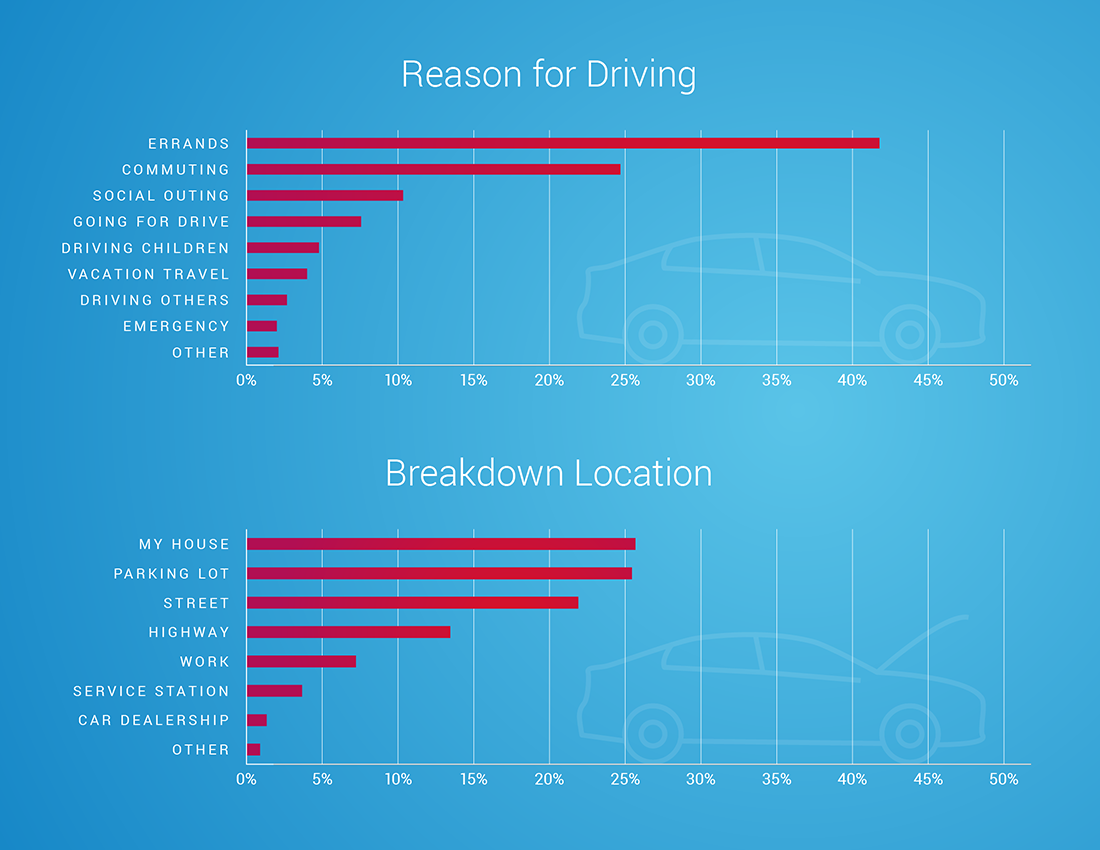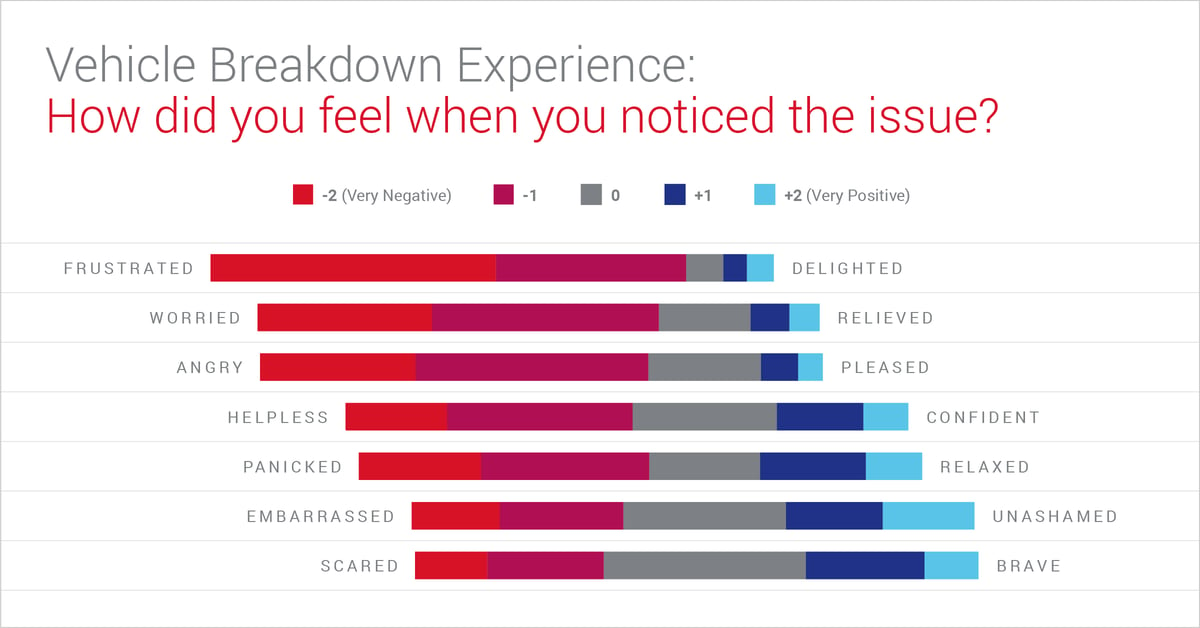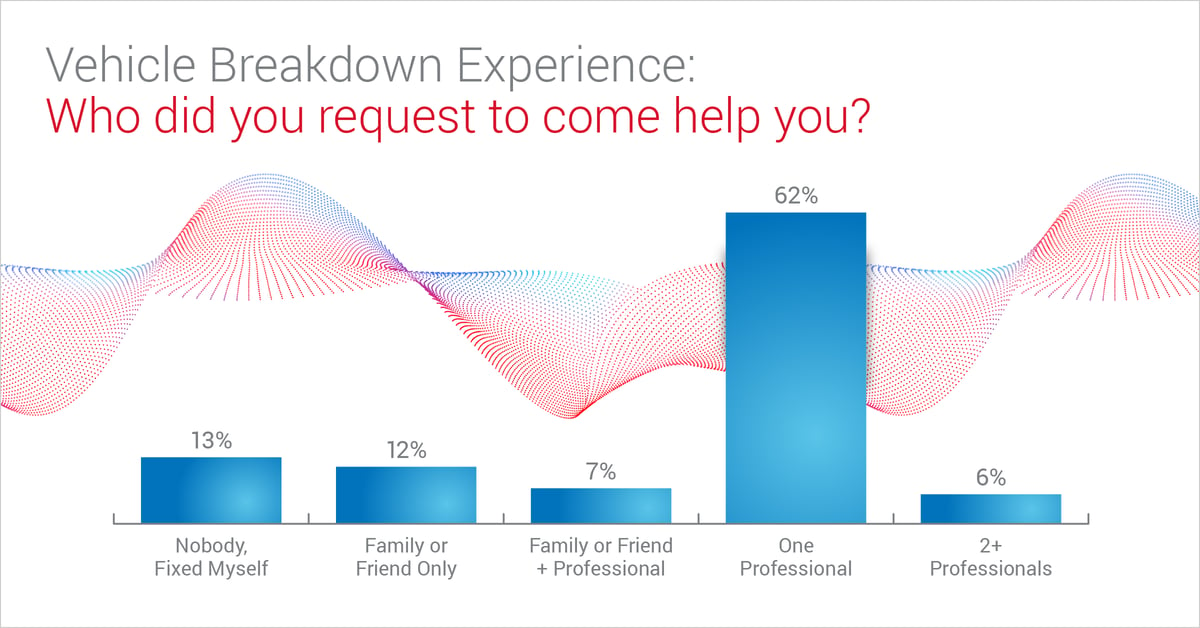We are serious about our mission to help drivers get their days back on track after a breakdown. By fulfilling this promise we not only make a meaningful difference for drivers who are having a truly bad day, we also help our insurance and automotive clients build customer loyalty. We regularly conduct research with consumers to keep a pulse on the market, inform our product strategy, and support our clients’ marketing efforts. To help us understand how consumers respond to breakdowns, we surveyed several hundred drivers to tell us about their experience during a recent roadside event.
Setting the Scene
First, we asked customers to paint a picture for us of where they were and what they were doing when their cars broke down. Here are some trends we found:


- Timing: Breakdown timing is consistent with general driving patterns – about three-quarters occur from Monday to Friday, and three-quarters occur during the daytime.
- Passengers: Drivers are alone in the car for over half of breakdowns. There is another adult in the car a quarter of the time.
- Driving status: Half of breakdowns occur while the car is being driven, the other half are discovered while the car is parked.
- Location: About one-third of breakdowns result in the driver stopping on a highway or street. A quarter are dealt with in a parking lot, and a quarter at home. About 80% of all breakdowns occur within 30 minutes from home.
- Reason for driving: Consumers are most frequently planning on doing errands when their cars break down, with commuting to or from work being the second most frequent reason for driving.
Dealing with the Breakdown
Then we asked customers to rate how they felt when the breakdown occurred.

Not surprisingly, most drivers felt frustrated, worried, and angry when their cars broke down. There were also large groups of drivers who felt panicked, helpless, embarrassed, and scared. However, there were many who fell on the positive end of the spectrum, expressing that they felt relaxed, confident, unashamed, and brave. Clearly, depending on the driver and the situation, initial reactions can vary significantly.
Finally, we asked customers who they decided to call to resolve the breakdown.

About three quarters of drivers called for professional roadside assistance to help with their breakdown, while the remaining quarter either tried to fix the issue themselves or relied on family or friends. Nearly 15% of the time, customers called multiple people for assistance – either two professionals or a professional plus family or friends. Most of the time, they did this to hedge their bets and ensure that they received the quickest service, but some also were concerned that one provider would not be able to resolve their issue.
Cater to Each Driver’s Situation
With every vehicle breakdown occurring under unique circumstances, drivers will vary on how they respond to the event and choose to resolve it. Insurance and automotive roadside programs will need to be prepared to meet the disparate needs of each customer. Here are a few recommendations on how to configure your roadside program to turn around your customers’ day no matter the situation:
- Make it easy for drivers to get the service they need. Imagine the state of mind of consumers who are frustrated to be dealing with a breakdown, and then layer on the panic and the fear that many are experiencing. Offering roadside assistance requests through your branded app makes it easy to find, quick to submit a request, and ensures that the service provider receives accurate breakdown and location information, resulting in higher customer NPS. However, some drivers may be comforted speaking with a live agent, so it is important to continue to offer assistance by phone as well.
- Accommodate customers who may not need or want immediate service. For the 35% of drivers whose cars break down at home or at work, it is sometimes more convenient to request service for a later time and move on with their day rather than dealing with the issue right then and there. Offering the option to pre-schedule roadside assistance lets consumers choose a time that fits their own schedule and takes one extra hassle off their plate.
- Help tow customers get where they need to go as quickly as possible. The biggest frustration expressed by consumers that we have spoken with is that breakdowns disrupt their plans, whether that means getting to a meeting at work or just getting home for dinner and a movie. Roadside programs can delight customers by offering a ride to their destination, rather than waiting for the tow truck to arrive and riding in the truck to the repair shop or dealership. Once again, busy drivers are given the flexibility to get on with their day and deal with their car issue at a time that is convenient for them.
- Keep drivers in the loop about the status of their service. Frequent status updates can help them plan out the rest of their day and give them peace of mind in a stressful situation. The right technology platform enables transparency with customers, providing accurate updates through multiple channels so that drivers know they are getting the help they need.
Each breakdown event is different, so there is no magic formula that will keep every customer satisfied. Providing options that allow drivers to feel in control of their own roadside experience, regardless of their situation, can go a long way to driving customer satisfaction and loyalty.
Check out this blog post for some more customer insights. We’ll keep them coming. In the meantime, safe driving!






 Shana Cooper leads the Product Marketing team at Agero. She joined the team in 2019 and has helped build and shape product content and education across all lines of business. Prior to Agero, Shana worked in a range of early stage start-ups covering everything from robots to biotech to IoT consumer products. She loves the challenge of helping to understand and communicate complex products. Shana has a BA in Chemistry from Colgate University and an MBA from Boston University.
Shana Cooper leads the Product Marketing team at Agero. She joined the team in 2019 and has helped build and shape product content and education across all lines of business. Prior to Agero, Shana worked in a range of early stage start-ups covering everything from robots to biotech to IoT consumer products. She loves the challenge of helping to understand and communicate complex products. Shana has a BA in Chemistry from Colgate University and an MBA from Boston University.